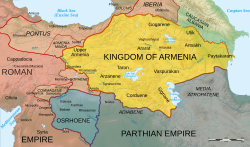Osrhoene
Osrhoene ( Osroene , Osrohene , Orrhoene , ancient Greek : Ὁσροηνή) describes a landscape in the northern Mesopotamia. As a result of the collapsing Seleucid Empire , from around 133 BC Establish a local kingdom. It included the area around Edessa (now Şanlıurfa , Turkey ). The local Aramaic dialect of Edessa, spoken by the majority of the population, became the precursor to Syriac . Today the region forms the border area between Syria and Turkey.
history
End of the 2nd century BC A dynasty of local rulers managed to establish themselves in a relatively small area east of the Euphrates . The empire was caught in the tension between Cappadocia, allied with Rome , in the west, the powerful kingdoms of Pontus in the north and Armenia in the northeast, and the aspiring Parthian Empire in the southeast.
After Pompey in 64 BC BC made the remains of the Seleucid Empire south of Osrhoene into the Roman province of Syria , and had smashed the Pontic Empire, Osrhoene, like Armenia, developed into a kind of buffer state between the Roman and Parthian spheres of influence. After the devastating defeat of Crassus in the Battle of Carrhae in 53 BC. The region first became Parthian. After Cappadocia and 72 Kommagene had finally become Roman in the year 17, the Euphrates established itself more and more as a border river.
Osrhoene was conquered by Emperor Trajan in 114, along with Armenia and Mesopotamia . However, there were revolts soon after in the conquered areas and Trajan's successor Hadrian immediately gave up all Roman claims there. The Roman candidate for the Parthian royal throne was resigned to the area of Osrhoene, which he also lost a few years later. Emperor Lucius Verus traversed the region in 165 on his successful campaign against the Parthians, after which it remained a semi-autonomous satellite state . During the Roman Civil War of 193–194, control of Osrhoene was briefly lost, but was restored by Septimius Severus in the Parthian Wars of 195 and 197–198.
In Osrhoene, a family ruled that produced a number of kings named Abgar. Abgar VIII (177–212) can possibly be considered the first Christian king in world history. The church father Eusebius of Caesarea does not report anything in his work about a conversion of the king. At least the king was open to Christianity.
The Roman Emperor Caracalla dethroned Abgar the Great's successor, his son Abgar IX, around 214 . , and made Osrhoene finally a Roman province, even if descendants of the royal family are attested later.
After the Parthian Empire was conquered by the Persian Sassanid dynasty in the 3rd century , Osrhoene became a disputed region in the border area between the Neo-Persian Empire and the East. After the siege of Edessa and Carrhae by Shapur I , the Romans suffered a heavy defeat here in 260, in which Emperor Valerian himself was taken prisoner. The ruler of the rich, almost independent desert city of Palmyra , allied with Rome , Septimius Odenathus , helped the Romans decisively to restore control of Osrhoene. However, his underage son Vaballathus turned against the Romans under the leadership of his mother Zenobia , was elevated to Augustus and was only defeated and captured by Aurelian in 272 with his mother . Until the conquest by the Arabs around 640, the Osrhoene remained a Roman province throughout late antiquity , with Edessa (which the Sassanids repeatedly besieged) as the governor's seat.
The kings of Osrhoene
- Aryu (132–127 BC)
- Abdu (127-120)
- Fradhasht (120-115)
- Bakru I. (115-112)
- Bakru II (112-94)
- Ma'nu I. (94)
- Abgar I. (94-68)
- Abgar II. (68-52)
- Ma'nu II (52-34)
- Paqor (34-29)
- Abgar III. (29–26)
- Abgar IV. (26-23)
- Ma'nu III. (23–4)
- Abgar V (4 BC-7 AD)
- Ma'nu IV (7-13)
- Abgar V. (13-50)
- Ma'nu V. (50-57)
- Ma'nu VI. (57-71)
- Abgar VI. (71–91)
- Sanatruk (91-109)
- Abgar VII (109-116)
- Roman occupation 116–118
- Yalur (118-122), with Parthamaspates
- Parthamaspates (118-123)
- Ma'nu VII (123-139)
- Ma'nu VIII (139-163)
- Wa'il (163-165)
- Ma'nu VIII. (165-177)
- Abgar VIII (the Great) (177–212)
- Abgar IX. (212-214)
See also
literature
- Fergus Millar (ed.): The Roman Empire and its neighbors. The Mediterranean World in Antiquity IV (= Fischer World History . Volume 8). Fischer Taschenbuch, Frankfurt am Main 1966, pp. 107, 117 ff, 201, 215 f, 218, 221.
- Andreas Luther : Elias of Nisibis and the chronology of the Kings of Edessen , in: Klio 81 (1999), pp. 180-198.
- Andreas Luther: The first kings of Osrhoene , in: Klio 81 (1999), pp. 437–454.
- Andreas Luther: Northern Mesopotamia and Rome. Investigations into the history of the kingdoms Osrhoene and Hatra (approx. 130 BC to approx. 250 AD) . Habilitation thesis, FU Berlin 2000.
Individual evidence
Coordinates: 37 ° N , 39 ° E

